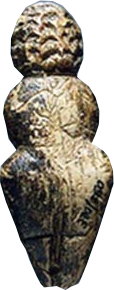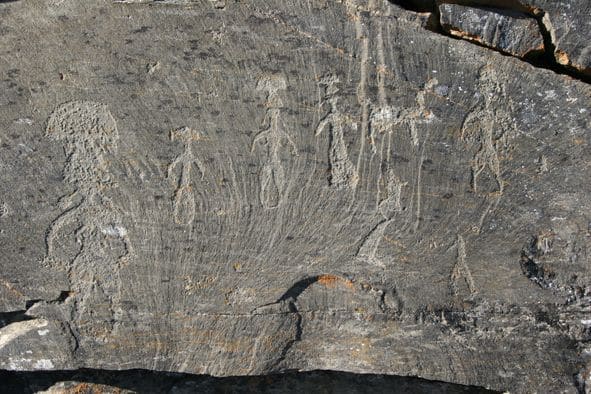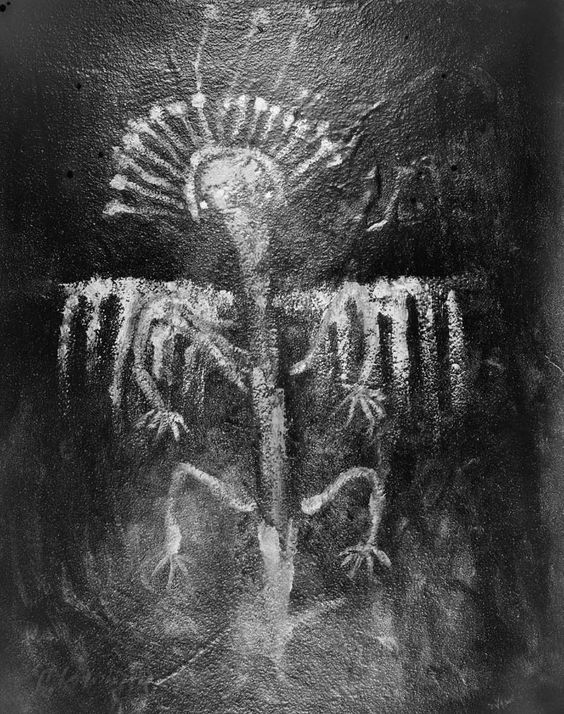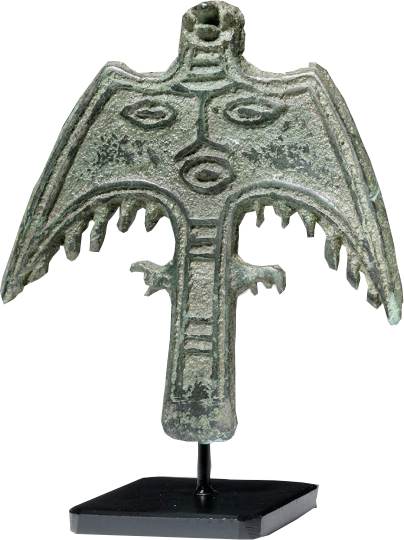Ancient Psychedelia: Alien Gods & Mushroom Goddesses
Online Book - Chapter 21, Page 418
Back to Online Book Mainpage / Next Page (Chapter 21, Page 419)
Use of soma in parts of Europe center first around northern Siberian tribes concentrated in the valleys of the Ob and Yenisei. Some of these tribes didn’t even know about alcohol until Russians introduced it in the 16th and 17th centuries but the amanita has been with them the entire time. We might keep in mind, Siberia is where the mammoth tusk goddess idols were discovered, which date to around 20,000 BC (8a). Siberia also hosts thunderbird and mushroom head rock glyphs (6a; 7g). A Russian bronze pendant from Western Siberia, c. 700-900 AD, shows the same thunderbird imagery as the rock glyphs (59a).   R: (7g) Near the Eastern bank of the Pegtymel River in Siberia c. 8000-1000 BC   R: (59a) Russian Bronze Pendant. Western Siberia Yamal Peninsula c. 700-900 AD Wasson’s ventures into Siberian shamanic amanita consumption yielded a tremendous amount of information in relation to the customs and habits of the people. It was found that in every case the mushrooms were dried first, and sometimes they were swallowed whole, without chewing. Many times, the women would chew it up, and give it to the men to swallow, because of the nauseating flavor. Somehow this was supposed to prevent the shaman from feeling ill upon consuming it. It was believed by some that you should eat the small ones with many warts, being the most powerful. Some held that it was proper to eat three at a time, as in one large one and two smaller ones. Among the Irtysh Ostyaks they either eat three or seven, swallowed whole. Some preferred to drink it with bilberry juice. The custom involves drying it first, then pouring water over it to reconstitute it and this is then boiled and the resulting mixture then filtered and drunk. Sometimes they are smoked. The Koryak told one observer that they are highly poisonous consumed fresh so they must be dried first, revealing even a superstition within the shamanic tribal community. |
mixture then filtered and drunk. Sometimes they are smoked. The Koryak told one observer that they are highly poisonous consumed fresh so they must be dried first, revealing even a superstition within the shamanic tribal community. One interesting thing to note is the use of a leather pouch to keep the mushrooms in. This seems to have created its own branch within mythology. Wasson cites J. Enderli, in Two Years Among the Chukchi and Koryak, from 1903: “At the man’s order, the woman dug into an old leather sack, in which all sorts of things were heaped one on top of another and brought out a small package wrapped in dirty leather from which she took a few old and dry fly agarics. She then sat down next to the two men and began chewing the mushrooms thoroughly. After chewing she took the mushroom out of her mouth and rolled it between her hands to the shape of a little sausage. The reason for this is that the mushroom has a highly unpleasant and nauseating taste, so that even a man who intends to eat it always gives it to someone else to chew and then swallows the little sausage whole, like a pill. When the mushroom sausage was ready, one of the men immediately swallowed it greedily by shoving it deep into his throat with his indescribably filthy fingers (for the Koryaks never wash in all their lives).” (21) Many scholars today researching the history of deliberate intoxication by humans are convinced that man discovered mushrooms before fermentation. Even the word for “inebriation,” Wasson claims, comes from this mushroom heritage. In his book Soma, Wasson cites Eliade in Shamanism when he writes: “The distillate of alcohol – what the French call l’alcool – is a late comer on the stage of history, but in the perspective of the past of Homo sapiens even fermented drinks are relatively recent. It is hard to see how the people of Siberia could have mastered the art of fermentation before they acquired the technique of making pottery or wineskins. Even today in the tropics there are primitive peoples (such as the Kuma of New Guinea) who did not know fermented drinks until the white man brought them in. It is significant that the Uralic word for ‘inebriation’ is taken from the name for the fly-agaric: in the sequence of history the food-gatherers must have discovered the natural inebriants long before they learned the art, tricky for those who performed it first, of fermentation.” (22) The Koryaks claim the mushroom doesn’t give them the negative after effects of alcohol such as headaches and prefer the A. muscaria to vodka. It is also believed among the Koryaks, that if one takes too many and feels troubled, a few heaping spoons of fat, oil or butter becomes a helpful remedy. (23) (21) Soma, Wasson, p. 153-54 (22) ibid, p. 333; Shamanism: Archaic Techniques of Ecstasy. Pantheon Books. New York, 1964, A translation from: Le Chamanisme et les Techniques archaiques de l'Extase. Paris 1951 (23) ibid, p. 155-56 |
Go Back to Page 417